Tattoo Removal in Nairobi, Kenya
Tattoo removal is a process that aims to eliminate an unwanted tattoo. There are several methods available, each with varying degrees of effectiveness, pain, and side effects.
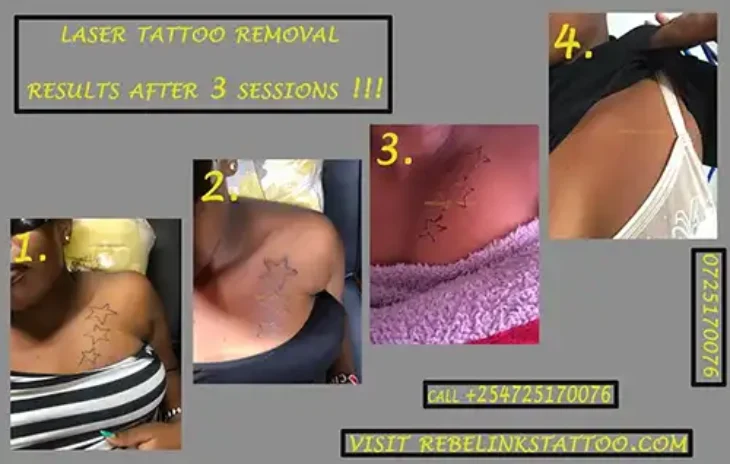
Tattoo Removal
Types of Tattoo Removal
1. Laser Tattoo Removal
Laser tattoo removal uses high-intensity light beams to break down the ink particles in the tattoo. The body’s immune system then gradually removes these smaller particles.
Types of Lasers:
- Q-switched lasers: These are the most common and effective lasers used. They include Q-switched Nd, Q-switched Ruby, and Q-switched Alexandrite lasers. Each type is suited for different ink colors.
- PicoSure and PicoWay lasers: These are newer technologies that deliver ultra-short pulses of energy, breaking down ink particles more efficiently and potentially requiring fewer sessions. They include Picosecond and PicoFractional lasers.
Pros:
– Highly effective for most ink colors.
– Minimal damage to surrounding skin.
Cons:
– Multiple sessions are usually required.
– Can be painful, often compared to the feeling of snapping rubber bands against the skin.
2. Surgical Removal (Excision)
The tattooed skin is surgically cut out, and the remaining skin is stitched back together. This method is usually reserved for small tattoos.
Pros:
– Complete removal in one session.
– Effective for small tattoos.
Cons:
– Leaves a scar.
– Not suitable for large tattoos.
3. Dermabrasion
A medical grinding tool is used to remove the top layers of skin, where the tattoo ink is located.
Pros: Can remove tattoos that are difficult to treat with lasers.
Cons:
– Can be painful and requires local anesthesia.
– Longer healing time and potential for scarring.
4. Chemical Peels
Chemical solutions, usually containing trichloroacetic acid (TCA), are applied to the tattooed skin to remove the top layers of skin.
Pros: Can be done at home with over-the-counter products, though professional treatment is more effective.
Cons:
– Less effective and less precise than laser removal.
– Higher risk of skin irritation and scarring.
5. Tattoo Removal Creams
Topical creams claim to fade tattoos by promoting skin regeneration and exfoliation.
Pros: Non-invasive and relatively painless.
Cons:
– Generally less effective than other methods.
– May cause skin irritation and allergic reactions.
6. Salabrasion
An older method that involves scrubbing the tattooed area with a salt solution to remove the top layers of skin.
Pros: Inexpensive and can be done at home.
Cons:
– Painful and less effective.
– High risk of scarring and infection.
7. Cryosurgery
The tattooed area is frozen with liquid nitrogen and then removed by dermabrasion.
Pros: Can be effective for some tattoos.
Cons:
– High risk of scarring and skin damage.
– Painful and requires anesthesia.
The best method for tattoo removal depends on various factors such as the size, color, and location of the tattoo, as well as your skin type and overall health. Consulting with a dermatologist or a tattoo removal specialist is crucial to determine the most appropriate and effective method for your specific situation.
Would you like more information on any specific method or have any other questions about tattoo removal? Get in Touch with one of our professionals for further consultation
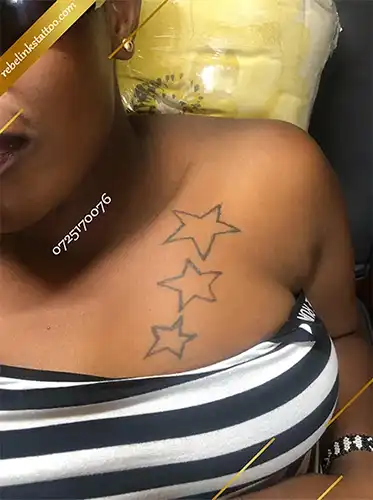
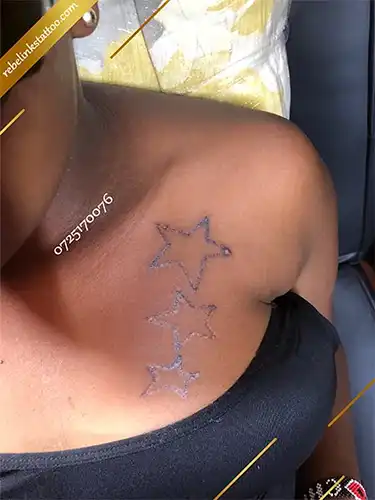
Factors to Consider for Tattoo Removal
When considering tattoo removal, it’s important to evaluate several factors to determine the best method and to set realistic expectations. Here are the key factors to consider:
- Tattoo Characteristics
– Size: Larger tattoos require more time and sessions to remove compared to smaller ones.
– Color: Different colors respond differently to various removal methods. Black and dark blue inks are easier to remove with lasers, while colors like green, yellow, and red can be more challenging. Laser Tattoo Removal of Black Ink vs. Color Ink →
– Age of the Tattoo: Older tattoos tend to fade more easily than newer ones, which often have more deeply embedded ink.
– Ink Quality and Depth: Tattoos with high-quality ink or those done by professional artists may have ink deposited deeper into the skin, making them more challenging to remove.
Tattoo Removal vs. Tattoo Cover-Ups → - Skin Type and Tone
– Skin Tone: Darker skin tones may require more cautious approaches to avoid hyperpigmentation (darkening) or hypopigmentation (lightening) of the skin. Certain laser types are better suited for darker skin tones. How Skin Types Affect Laser Tattoo Removal →
– Skin Sensitivity: Sensitive skin may be more prone to irritation, scarring, or other side effects from the removal process. - Location of the Tattoo
– Body Area: Tattoos in areas with more blood flow (such as the chest and back) tend to heal faster and may respond better to removal treatments compared to areas with less circulation (such as hands and feet).
– Skin Thickness: Thicker skin areas may require more sessions to completely remove the tattoo. - Health Considerations
– Overall Health: Your general health can affect how well your body responds to tattoo removal. Conditions such as immune disorders, diabetes, or certain skin conditions may influence the healing process.
– Smoking: Smoking can impair blood circulation and slow down the healing process, potentially making tattoo removal less effective and increasing the risk of complications. - Removal Method
– Effectiveness: Different methods have varying success rates depending on the tattoo’s characteristics and the individual’s skin type.
– Pain and Discomfort: Some methods, like laser removal and surgical excision, can be more painful than others. Pain tolerance and willingness to endure discomfort should be considered.
– Number of Sessions: Some methods require multiple sessions over several months. It’s important to understand the time commitment involved.
– Cost: Tattoo removal can be expensive, especially for methods requiring multiple sessions. Consider your budget and whether the cost is manageable.
How to Prepare for Your First Tattoo Removal Session → - Side Effects and Risks
– Scarring: Some methods, particularly surgical removal and dermabrasion, have a higher risk of scarring.
– Pigmentation Changes: There is a risk of hyperpigmentation or hypopigmentation, especially in individuals with darker skin tones.
– Infection: Any procedure that breaks the skin carries a risk of infection. Following proper aftercare instructions is crucial.
– Allergic Reactions: Some individuals may experience allergic reactions to tattoo ink or removal creams. - Aftercare and Recovery
– Healing Time: Different methods have varying healing times. Be prepared for the aftercare requirements and any activity restrictions during the healing process.
– Follow-Up Care: Some methods require follow-up care or additional treatments to achieve the desired results. Make sure you’re committed to the full course of treatment. - Expectations
– Realistic Outcomes: Complete removal without any trace is not always possible. Some tattoos may only be lightened significantly rather than entirely removed.
– Consultation with Specialists: Consult with qualified dermatologists or tattoo removal specialists to get a professional assessment and to understand what results can be realistically achieved.
Considering these factors can help you make an informed decision about tattoo removal and choose the method that is best suited to your specific situation. If you have any other questions or need more details, feel free to Contact Us.
Learn More on How Lifestyle Affects Tattoo Removal Speed →
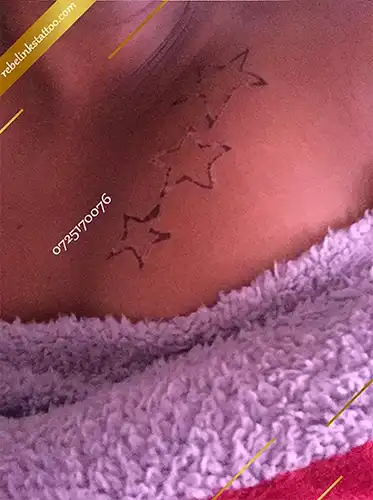


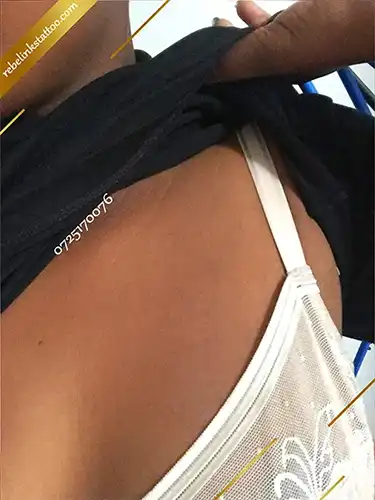


Cost of Tattoo Removal in Nairobi, Kenya
The cost of tattoo removal can vary widely depending on several factors, including the method used, the size and complexity of the tattoo, the number of sessions required, and the geographic location of the treatment. Here’s a breakdown of the costs associated with different tattoo removal methods:
Laser Tattoo Removal
Average Cost per Session: Ksh. 5,000 to Ksh. 100,000
Total Cost:
- Small Tattoos: Ksh. 5,000 to Ksh. 25,000
- Medium Tattoos: Ksh. 18,000 to Ksh. 35,000
- Large Tattoos: Ksh. 12,000 to Ksh. 100,000
Factors Influencing Cost:
- Number of Sessions: Most tattoos require 6 to 12 sessions, but some may need more.
- Tattoo Colors: Multicolored tattoos may need different lasers and more sessions.
- Ink Depth: Professional tattoos with deeper ink layers can be more costly to remove.
Additional Costs to Consider
- Consultation Fees: At Rebel Inks Tattoos, Tattoo Removal, and Body Piercings Parlour we might charge a consultation fee, typically ranging from Ksh. 500 to Ksh. 2,000.
- Aftercare Products: At Rebel Inks Tattoos, Tattoo Removal, and Body Piercings Parlour we have special creams, bandages, and other aftercare products may add to the total cost.
- Follow-Up Treatments: Additional treatments for scar reduction or pigmentation issues may be necessary, adding to the overall expense.
When considering tattoo removal, it’s important to get a detailed cost estimate during your consultation with our specialist. Our specialist will provide a personalized treatment plan, including the number of sessions required and the associated costs. At Rebel Inks Tattoos, Tattoo Removal, and Body Piercings Parlour we have a team of reputable and experienced specialists to ensure the best possible results and minimize risks.
Get In Touch
For more information on the list above and any other special services,please call or come in for free consultation
Testimonials
After he pierced my industrial piercing and seeing his amazing work, I feel even more excited about getting my tattoo with him in January. I’m really looking forward to it!
I am extremely happy with my new 'Safari' tattoo from Eric at Rebel Inks! The quality of the artwork is fantastic. Eric is a true professional and an amazing artist.
The preparation and design process was thorough and collaborative. He was very patient with my specific requests, including making sure all the elements, which hold personal meaning, were perfect.
The service was friendly and highly professional from start to finish. Despite the 8-hour session, Eric was a pleasant person to spend the time with.
The aftercare guidance and follow-up have been excellent and careful, which has made the healing process easy and better than expected.
I highly recommend Eric for anyone looking for a thoughtful, talented, and caring tattoo artist.
I recommend them 💯
I would definitely recommend if you’re thinking of getting a piercing!
The staff were super friendly, explained everything clearly, and made me feel so at ease. They answered all my nervous questions (and I had many questions),
They walked me through the whole process, gave detailed aftercare instructions, and even followed up afterward to check how I was healing 🫶
Clean, professional, and full of good vibes.
Would 100% recommend . Definitely making a second trip here.
This was the second tattoo I got and I wish I could have come to Eric for my first one! He gave me really great after-care directions for the tattoo as well as a little jar of his own Vaseline-type stuff to put over my tattoo while it was healing! He even put second skin over my tattoo so that I didn’t have to worry about it for the first few days. Now THAT’S good service. My first tattoo artist didn’t do none of that lol.
After the session Eric didn’t rush me and my friend out, he chatted with us and even when he found out I was an artist too— really encouraged me to keep creating and to find a community of artists to support me. I almost cried because I’ve had such a hard time with my own art the past couple of years, it meant so much to me to have a fellow very talented artist say that to me. 🤍🤍🤍
Eric you’re amazing, don’t ever stop creating and just know you’ve impacted lives all over the world!🫶🏻 thanks so much for everything!!
From the moment I walked in, Eric was professional, welcoming, and attentive. He made sure I was comfortable throughout, provided everything I needed, and explained every step of the process. The tattooing itself was unbelievably smooth - I genuinely felt no pain compared to my previous tattoos over the last 22 years.
Eric also gave me excellent aftercare guidance and products, and thanks to that, my tattoo healed beautifully. The attention to detail, precision, and shading are absolutely stunning. This is hands-down the best tattoo I've ever had, and I will be flying back to Nairobi for any future ink.
If you want incredible art, a professional experience, and a talented artist who truly cares about his clients, Rebel Ink is the place to go!
From start to finish, the service was exceptional. The piercer was professional, knowledgeable, and made me feel completely comfortable. The cleanliness of the place was above and beyond — everything was spotless and hygienic, which really put me at ease. Highly recommend for anyone considering a piercing!
Shout out to Eric😘
We ended up changing the jewelry three times to ensure I had the best fit and avoided any signs of rejection, and he always listened to my suggestions as a client, which I really appreciated. Now, three months in, my piercing is healing beautifully, with no sign of rejection. Highly recommend for anyone who values a piercer who cares about your comfort and healing journey!
What stood out the most was the aftercare Eric checked in with me even three weeks later to see how the tattoo was healing. That kind of follow-up shows how much he truly cares about his work and his clients.
I’m very satisfied and will definitely be coming back for my next piece. Highly recommend!
The piercing wasn't as painful as I had thought and the process was quick and satisfactory. I love it!!!
The piercing is healing well thanks to the aftercare instructions and follow-up. I would highly recommend Rebel Inks
Eric also did a belly button piercing for a friend, guiding her through the process, doing the piercing and then explaining the after care to her.
The shop is on the 3rd floor, with the entrance to the stairs near an alleyway on the left. The shop is perfect size, clean, and attractive looking. The mural is pretty dope.
Thank you for the amazing service! 🔥👅✨
I got piercibgs there and the process was really good. My biggest concern was hygiene but that wasn't an issue at all, they use new needles and they sanitize them.
The service itself was also welcoming.
I was informes of everything i needed to know beforehand.
10/10 would recommend!
Eric was so calm and patient with my almost 2 year old lady. It was such a clean and hygienic process. We will definitely be back for our second rounds of piercings and maybe even another tattoo!
They assess the area before any art and advise one accordingly. They also give one post clean up process and also do a check up after the body art projects. Overall, I loved my experience and I’m hooked. 👍
Will definitely come back next time I’m in town 🙂
He listened to what I actually wanted and made sure he could fit in the time before I flew back home.
The shop is clean & private and is easy enough to find.
Eric has even checked in a couple of times since to make sure all is good.
I would totally recommend Eric! I absolutely love my Elephants!
I had a very easy healing period and always follow up from Eric to check on my progress...I would highly recommend if you are a first timer because from my experience all went very well and attention to detail
Thank you for a good job and looking forward to send all my friends your way
And all the best with the new year 2025!
From the moment I walked in, the staff was super friendly and made me feel at ease. The studio had a clean, professional atmosphere, which immediately put me at ease. My piercer was incredibly skilled and explained every step of the process, ensuring I was comfortable the entire time. The piercing was quick and practically painless, and the aftercare instructions were clear and easy to follow. I can tell they really care about the health and safety of their clients.
Overall, a fantastic experience—I highly recommend Rebel Inks and Tattoos for anyone looking to get pierced or tattooed!
They do follow up after their services
Eric's Studio isn’t just a place to get a tattoo—it’s an experience. The combination of professionalism, artistic talent, and a welcoming environment makes it a standout destination for anyone considering a tattoo.
I highly recommend Eric’s Studio to both first-timers and seasoned tattoo enthusiasts. If you’re looking for a high-quality tattoo and an enjoyable experience, this is the place to go.
I would definitely recommend their services again and again
Thank you Rebel Ink
My piercings are healing ❤️🩹 well
I would 💯 recommend
I will definitely come back for more .
Two, all the equipments he used for the piercings were new and/or sterilised.
Three, the parlour itself was very clean and was up to par with the hygiene standards.
Four, Eric provided effective aftercare instructions, making sure I knew exactly how to take care of my new piercings and he kept in touch and continues to do so, to check on the healing progress.
I highly highly highly recommend this place!!!
Would definitely recommend them to friends and go back for other piercings
Not only was the piercing process smooth, but he also provided thorough aftercare instructions, making sure I knew exactly how to take care of my new piercings. What really impressed me was that he keeps in touch to check on how the healing is progressing – a sign of true care for his clients.
The shop maintains a high standard of hygiene, and the atmosphere is welcoming and comfortable, which really added to the positive experience. I highly recommend this place to anyone looking for a professional and caring experience. I’ll definitely be coming back for any future piercings!
My appreciation for the excellent customer service I received. The follow-ups were prompt, and I truly appreciated the gentleness and professionalism throughout. Thank you!"
"Looking for professional eyebrow microshading removal? Look no further!"
The customer care is top tier 👌🏾👌🏾.
Wonderful place to get tattoos and piercings. 💯💯
Eric goes ahead to follow up on his clients progress and gives good advice each time I reach out to him.
I would recommend Reble tattoos anytime.
Good job bro we really appreciate.
Ohh and the price is very fair.
The environment was clean , procedure was sterile and the jewelry used are of the best quality.
He followed up with me during the healing process, he educated me on what I needed to do for my aftercare.
Eric is confident, skilled , experienced and the best piercer. Highly recommend Rebel inks.✨
Definitely recommend!
Great experience.
Eric definitely know what he is doing .
I got exactly what I wanted 2 tiny tats on the same finger .
He was kind and patient throughout the session.
Healing process has been good .
Aftercare services were given and regular checkups on the healing process were done.
I would 💯recommend.
Eric gave me the best reception as it was my first time there,and made me trust him all the way. I appreciate good services.
There services are also affordable not to forget 😊.
He was also invested in the aftercare and would ensure I follow the do's and don'ts in taking care of the tattoo and ensuring proper healing and maximum ink retention.
Would highly recommend Rebel Inks Tattoos.
Rebel Inks Tattoo offer the best,affordable and quality tattoo removal services.If you have unwanted ink,choose Rebel Inks Tattoo,they're the best of the best and the professionalism is a top notch.They ensure you're free from unwanted ink with their Laser Tattoo Removal Technology...
I did a Laser Tattoo Removal with them and i can attest they're the best....
Kudos Eric...
I highly recommend.
It was a generally good experience with good hygiene during the piercing process and has been a smooth healing process.... 10/10
tips. Highly recommend 👍🏽
100% recommendable.
I was particularly impressed with Eric's attention to hygiene. He thoroughly cleaned the room before I entered, sanitized all of the equipment he would be using, and changed gloves between each ear. This level of cleanliness gave me great confidence in his professionalism.
Eric's commitment to customer service did not end on the day of the piercing. He followed up with me regularly throughout the healing process to ensure that I was following the aftercare instructions and that my earlobes were healing properly.
I highly recommend Rebel Inks to anyone in Nairobi who is considering getting a piercing. Eric is a highly skilled and experienced piercer who takes great pride in his work.
So I Check all the boxes below and more:
Customer Care: ✔️
Professionalism : ✔️
Cleanliness ✔️
Price: ✔️
After care service ✔️
Thanks and good job, Eric
The place is neat and clean and the equipments he used were also fine standards. Really appreciate his following up with me on the healing 🤗
I WOULD HIGHLY RECOMMEND THEIR SERVICES to everyone. Actually what you see on their website is EXACTLY what you will get. Keep up the good work Rebel inks Tattoos.
The infection is now gone. I would definitely recommend!
Can recommend this place totally and would go back there anytime!
Thanks!
OUR LOCATION
Areas We Serve
NAIROBI
KIAMBU
KAJIADO
MACHAKOS
















































































































































































































